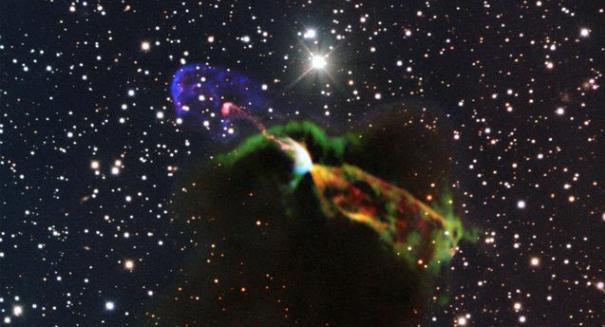
The observations were acquired in a mere five hours of ALMA observation time.
Utilizing the Atacama Large Millimeter/submillimeter Array, also known as ALMA, astronomers have captured a stunning image of the dramatic birth of a star.
By examining the glow originating from carbon monoxide molecules in an object called Herbig-Haro 46/47 astronomers have found that its jets are even more full of life than previously believed. In addition, the new photos also showed a previously undiscovered jet oriented in a completely different direction.
Youthful stars are destructive objects that discharge materials at extremely high rates of speed. When this material smashes into the encircling gas it glows, producing a Herbig-Haro object. Herbig-Haro 46/47 is located approximately 1400 light-years from our planet in the southern constellation of Vela. According to astronomers, this object was the focus of a study utilizing ALMA when the telescope was still being built and well before the array was finished.
The new photos show minute detail in two jets, one moving towards Earth and one traveling away. The vanishing jet was nearly invisible in earlier pictures taken in visible light, because of concealment by the dust clouds encircling the infant star. ALMA has not only obtained much clearer images than earlier instrument but also given astronomers the chance to determine how quickly the glowing material is traveling through space.
These new observations of Herbig-Haro 46/47 showed that some of the discharged material had speeds much higher than had been determined before. This suggest that the outflowing gas has a lot more energy and momentum that previously believed.
“ALMA’s exquisite sensitivity allows the detection of previously unseen features in this source, like this very fast outflow. It also seems to be a textbook example of a simple model where the molecular outflow is generated by a wide-angle wind from the young star,” said first author Héctor Arce of Yale University.
The observations were acquired in a mere five hours of ALMA observation time. According to the astronomers, comparable quality observations with other telescopes would have likely taken much longer.
“The detail in the Herbig-Haro 46/47 images is stunning. Perhaps more stunning is the fact that, for these types of observations, we really are still in the early days. In the future ALMA will provide even better images than this in a fraction of the time,” said co-author Stuartt Corder of the Joint ALMA Observatory.
The quality of the ALMA observations also helped the astronomers find an undiscovered outflow component that appears to be originating from a lower mass companion to the young star. This secondary outflow is observed nearly at right angles to the main object and is seemingly sculpting its own hole out of the encircling cloud.
What is your reaction to the picture of a star birth? What is your favorite space photo of all time? Share your thoughts in the comments section.
Leave a Reply